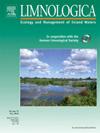Ecosystem engineering at the regional scale—Beaver impact on floodplain pondscapes
IF 2
4区 环境科学与生态学
Q2 LIMNOLOGY
引用次数: 0
Abstract
Currently, global climate change has led to alterations in river discharge. In Eastern and Southern Europe, decreasing spring flood levels are observed, leading to drying and overgrowth of floodplain water bodies, especially in semiarid regions. Under such conditions, the scale of influence of the ecosystem engineer, the Eurasian beaver, which is often considered one of the tools for wetland restoration, is of interest. The aim of this study was to analyze beaver digging activity on a regional scale by estimating beaver abundance and occurrence patterns in floodplain pondscapes of the upper Khoper River and by quantifying changes in the morphometric parameters of water bodies due to the impact of this species. During the field survey and remote GIS analysis, 80 water bodies were surveyed. The results of the field study revealed that 67 % of the water bodies were inhabited by beavers, 21 % of which were inhabited by large families. Only 5.6 % of the water bodies had no traces of beaver activity. Approximately 30 % of all the water bodies under study were significantly altered, and 10–13 % were almost completely excavated by beavers. The remote sensing analyses revealed that beavers digging increased the area of the water bodies by an average of 40 %, the perimeter of the water bodies by an average of 60 %, and the shoreline development (complexity) by 60 %. In total, beaver-created structures occupied 0.05 km2 in the floodplain of the upper reaches of the river, and their total length reached 30.5 km. The main factor influencing beaver digging activity was the drying of water bodies; the values of morphometric parameters altered or created by beavers increased significantly at large differences in the maximum and minimum water levels. Our results highlight the importance of ecosystem engineering activities at the regional scale in the face of climate change and provide insight into the possibility of considering beaver digging activities as an inspiration for the development of nature-based strategies.
区域范围内的生态系统工程--河狸对洪泛区池塘景观的影响
目前,全球气候变化已导致河流流量发生变化。在东欧和南欧,春季洪水位下降,导致洪泛区水体干涸和过度生长,尤其是在半干旱地区。在这种情况下,生态系统工程师欧亚河狸(通常被认为是湿地恢复的工具之一)的影响范围就引起了人们的兴趣。本研究的目的是通过估算河狸在霍珀河上游洪泛平原池塘景观中的数量和出现模式,以及量化该物种影响下水体形态参数的变化,分析河狸在区域范围内的挖掘活动。在实地调查和远程 GIS 分析期间,共调查了 80 个水体。实地研究结果显示,67%的水体有海狸栖息,其中 21%的水体有大家族栖息。只有 5.6% 的水体没有海狸活动的痕迹。在研究的所有水体中,约有 30% 的水体被海狸严重改变,10-13% 的水体几乎完全被海狸挖掘。遥感分析显示,海狸挖掘使水体面积平均增加了 40%,水体周长平均增加了 60%,海岸线发展(复杂性)增加了 60%。在河流上游的洪泛区,海狸建造的建筑物总共占地 0.05 平方公里,总长度达 30.5 公里。影响海狸挖掘活动的主要因素是水体的干涸;在最高水位和最低水位相差较大的情况下,海狸改变或创造的形态参数值会显著增加。我们的研究结果凸显了面对气候变化在区域范围内开展生态系统工程活动的重要性,并为将海狸挖掘活动视为制定基于自然的战略的灵感提供了启示。
本文章由计算机程序翻译,如有差异,请以英文原文为准。
求助全文
约1分钟内获得全文
求助全文
来源期刊

Limnologica
环境科学-湖沼学
CiteScore
3.70
自引率
5.90%
发文量
64
审稿时长
3 months
期刊介绍:
Limnologica is a primary journal for limnologists, aquatic ecologists, freshwater biologists, restoration ecologists and ecotoxicologists working with freshwater habitats.
 求助内容:
求助内容: 应助结果提醒方式:
应助结果提醒方式:


